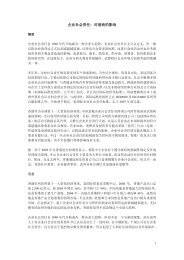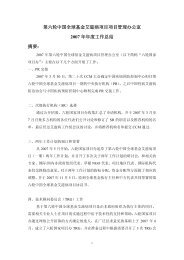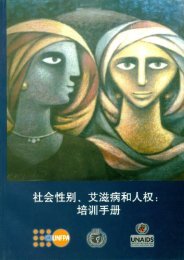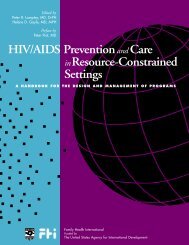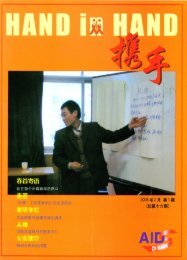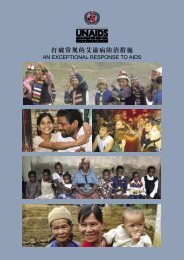The Training of Trainers Manual - UNFPA
The Training of Trainers Manual - UNFPA
The Training of Trainers Manual - UNFPA
Create successful ePaper yourself
Turn your PDF publications into a flip-book with our unique Google optimized e-Paper software.
Handout 17 • Challenges to Building Effective Youth-Adult Partnerships 17<br />
Attitudes as challenges<br />
Some adults still believe that the opinions <strong>of</strong> young people do not matter, that youth are not capable <strong>of</strong><br />
contributing in a valuable way, and that adults have nothing to learn from youth. <strong>The</strong>se types <strong>of</strong> attitudes<br />
about youth might be viewed from the perspective <strong>of</strong> cultural diversity, where firsthand experience<br />
can be an effective strategy for changing attitudes. For example, involving young people at high levels<br />
<strong>of</strong> responsibility and decision-making enables adults to see that youth can be thoughtful and make<br />
important contributions. When someone comes to see a formerly undifferentiated group as diverse, that<br />
person becomes more likely to value the individuals within the group and let go <strong>of</strong> stereotypes.<br />
Power dynamics, usually rooted in cultural norms, may contribute to challenges <strong>of</strong> youth-adult<br />
partnerships. Formal instruction in school <strong>of</strong>ten teaches youth to expect adults to provide answers and<br />
to ignore, deride, or veto youth ideas. Adults frequently underestimate the knowledge and creativity <strong>of</strong><br />
young people and may be accustomed to making decisions without input from youth, even when youth<br />
are directly affected by the decisions. <strong>The</strong>refore, successful partnerships require deliberate effort on the<br />
part <strong>of</strong> both adults and youth.<br />
Spectrum <strong>of</strong> attitudes<br />
According to the ‘spectrum <strong>of</strong> attitudes’ theory, adults may have one <strong>of</strong> three types <strong>of</strong> attitudes about<br />
young people’s ability to make good decisions. <strong>The</strong>se attitudes also determine the extent to which adults<br />
will be willing to involve young people as significant partners in decisions about programme design,<br />
development, implementation, and evaluation.<br />
■ Youth as objects. Adults who have this attitude believe they know what is best for young people,<br />
attempt to control situations involving youth, and believe that young people have little to contribute.<br />
<strong>The</strong>se adults seldom permit youth more than token involvement. For example, an adult might write<br />
a letter to an elected <strong>of</strong>ficial about an issue pertinent to youth and use a young person’s name<br />
and signature for impact. Adults may feel the need to protect youth from the consequences<br />
<strong>of</strong> potential mistakes.<br />
■ Youth as recipients. Adults who have this attitude believe they must help youth adapt to adult<br />
society. <strong>The</strong>y permit young people to take part in making decisions because they think the<br />
experience will be good for them, but they also assume that youth are not yet self-sufficient<br />
and need practice to learn to think like adults. <strong>The</strong>se adults usually delegate to young people<br />
responsibilities and tasks that the adults themselves do not want to undertake. <strong>The</strong> adults usually<br />
dictate the terms <strong>of</strong> youth’s involvement and expect young people to adhere to those terms;<br />
the adults might deliberately retain all power and control. For example, adults who view youth<br />
as recipients might extend an invitation to one young person to join a board <strong>of</strong> directors that is<br />
otherwise comprised solely <strong>of</strong> adults. In such a setting, a young person’s voice is seldom raised and<br />
little heard – adults do not expect the young person to contribute, and the young person knows it.<br />
Section 4. Participant Handouts<br />
165




